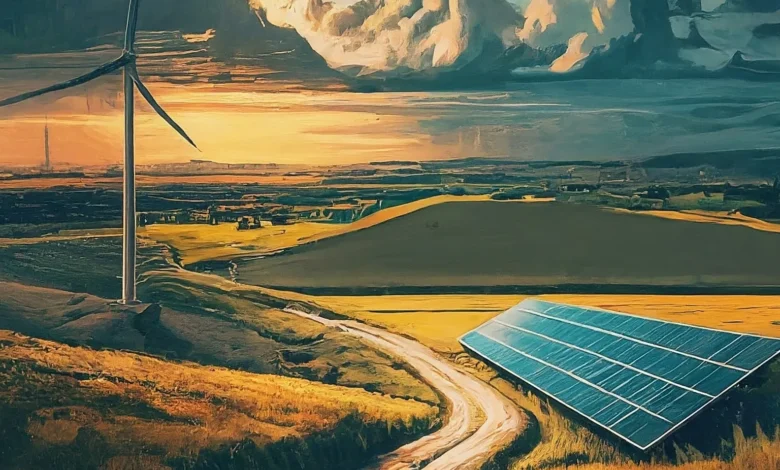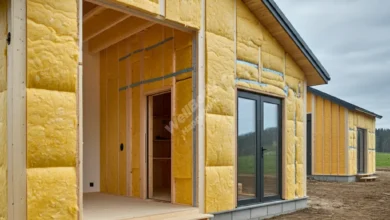Greening the Grid: Understanding Renewable Energy at Home

Have you ever wondered how you could power your home using the sun, wind, or even the earth itself? Welcome to the world of renewable energy at home!
In today’s climate-conscious world, more and more homeowners are turning to clean energy sources to power their lives. Did you know that in 2020, renewable energy sources accounted for about 20% of U.S. electricity generation? This number is growing every year, and you can be part of this green revolution!
In this article, we’ll explore:
- What renewable energy really means
- Popular options for powering your home with clean energy
- How to get started on your renewable energy journey
Let’s dive in and discover how you can make your home a beacon of sustainability!
What is Renewable Energy?
Renewable energy comes from sources that naturally replenish themselves. Unlike fossil fuels, which will eventually run out, renewable energy sources are constantly renewed by natural processes.
Here are some common types of renewable energy:
- Solar power
- Wind power
- Hydropower
- Geothermal energy
- Biomass energy
Let’s compare renewable and non-renewable energy sources:
| Renewable Energy | Non-Renewable Energy |
|---|---|
| Unlimited supply | Limited supply |
| Low emissions | High emissions |
| Initial high cost | Ongoing fuel costs |
| Weather-dependent | Consistent supply |
Popular Renewable Energy Options for Homes
Solar Power
Solar power is one of the most popular options for home renewable energy systems. It works by converting sunlight into electricity using solar panels.
How it works:
- Sunlight hits the solar panels
- Panels convert sunlight to DC electricity
- An inverter changes DC to AC power
- AC power is used in your home or sent to the grid
Pros and cons of solar power:
Pros:
- Low operating costs
- Clean and quiet
- Increases home value
Cons:
- High upfront costs
- Weather-dependent
- Requires suitable roof space
When considering residential solar power, think about your roof’s sun exposure, local climate, and energy needs.
Wind Power
Wind power harnesses the energy of moving air to generate electricity. While less common for homes, it can be a great option in windy areas.
Advantages of wind power:
- Works day and night
- Uses less space than solar panels
- Can be very efficient in the right location
Limitations:
- Requires consistent wind speeds
- May face zoning restrictions
- Can be noisy
Wind power is best suited for homes with large, open spaces and steady wind conditions.
Geothermal Energy
Geothermal energy taps into the earth’s constant temperature to heat and cool your home. It uses a system of underground pipes filled with water or refrigerant.
Benefits of geothermal energy:
- Very efficient
- Works in any climate
- Long-lasting system
Drawbacks:
- High installation costs
- Requires suitable land for installation
- Limited number of qualified installers
Geothermal systems work well in most regions but are especially effective where heating and cooling needs are balanced.
Getting Started with Renewable Energy at Home
Energy Audit: Assessing Your Home’s Energy Needs
Before diving into renewable energy, it’s crucial to understand your energy consumption. An energy audit helps you:
- Identify energy waste
- Determine your average energy usage
- Pinpoint areas for improvement
You can hire a professional or use online tools for a DIY energy audit. This step is key to choosing the right renewable energy system for your home.
Choosing the Right Renewable Energy System
Selecting the best system depends on several factors:
- Your location and climate
- Available space (roof or land)
- Energy needs
- Budget
- Local regulations
It’s wise to consult with professionals who can assess your specific situation and recommend the most suitable options.
Costs and Financial Considerations
Renewable energy systems often have high upfront costs but offer long-term savings. Here’s what to consider:
- Initial investment: Varies by system type and size
- Long-term savings: Reduced or eliminated energy bills
- Payback period: Time to recoup your investment
Available incentives and rebates:
- Federal tax credits
- State rebates
- Local utility incentives
- Net metering programs
These incentives can significantly reduce your initial costs, making renewable energy more accessible.
Integration with Existing Home Systems
Grid-tied vs. Off-grid Systems
When installing a home renewable energy system, you have two main options:
Grid-tied systems:
- Connect to the main power grid
- Can sell excess energy back to the utility
- Rely on grid power when renewable sources are insufficient
Off-grid systems:
- Completely independent from the main grid
- Require robust energy storage solutions
- Need careful planning to ensure consistent power supply
Most homeowners opt for grid-tied systems due to their reliability and cost-effectiveness.
Energy Storage Solutions
Storing energy is crucial, especially for off-grid systems or areas with unreliable grid power. Common storage options include:
Batteries:
- Store excess energy for later use
- Provide backup power during outages
- Examples: Lithium-ion, lead-acid batteries
Other storage technologies:
- Thermal storage (for heating/cooling)
- Pumped hydro storage (for larger properties)
Smart Home Integration for Energy Management
Smart home technology can optimize your renewable energy system:
- Smart meters track energy production and consumption
- Automated systems adjust energy use based on production
- Mobile apps allow remote monitoring and control
These technologies help you maximize efficiency and get the most out of your renewable energy investment.
Environmental Impact and Benefits
Reducing Carbon Footprint
Switching to renewable energy significantly reduces your carbon footprint. For example:
- A typical home solar system can offset about 3-4 tons of carbon emissions annually
- This is equivalent to planting about 100 trees each year!
Contribution to Global Sustainability Efforts
By adopting renewable energy, you’re:
- Supporting the transition to clean energy
- Reducing demand for fossil fuels
- Inspiring others in your community to go green
Personal Benefits Beyond Environmental Impact
Renewable energy offers several personal advantages:
- Energy independence
- Protection against rising energy costs
- Increased home value
- Sense of contributing to a cleaner future
These benefits combine to make renewable energy a win-win for both you and the environment.
Overcoming Common Challenges
Addressing Misconceptions about Renewable Energy
Let’s debunk some myths about home renewable energy systems:
“They don’t work in cloudy or cold climates”
- Fact: Solar panels still work on cloudy days, just less efficiently
- Wind turbines can be more effective in colder, denser air
“They’re too expensive”
- Fact: Costs have dropped significantly in recent years
- Long-term savings often outweigh initial investments
“They require too much maintenance”
- Fact: Most systems need minimal upkeep
- Professional check-ups once or twice a year are usually sufficient
Dealing with Intermittency Issues
Renewable energy sources like solar and wind are intermittent by nature. Here’s how to manage this:
- Energy storage systems (e.g., batteries) store excess power for later use
- Grid-tied systems allow you to draw from the grid when needed
- Combining multiple renewable sources can provide more consistent power
Navigating Local Regulations and Permits
Before installing a renewable energy system:
- Check local zoning laws and homeowners’ association rules
- Obtain necessary permits from your local government
- Ensure your system meets all safety and building codes
Working with a reputable installer can help you navigate these requirements smoothly.
Future of Residential Renewable Energy
Emerging Technologies
Exciting developments are on the horizon:
- More efficient solar panels with higher energy conversion rates
- Advanced energy storage solutions for longer-lasting power
- Smart grids that optimize energy distribution
- Building-integrated renewables, like solar roof tiles
These innovations will make renewable energy even more accessible and effective for homeowners.
Predictions for Increased Adoption
Experts predict a significant increase in residential renewable energy adoption:
- Falling costs will make systems more affordable
- Improved technology will enhance efficiency and reliability
- Growing environmental awareness will drive demand
By 2030, residential solar installations are expected to triple in many countries.
Potential Impact on Energy Markets
As more homes adopt renewable energy:
- Traditional energy providers may need to adapt their business models
- Energy decentralization could lead to more resilient power grids
- We may see new opportunities for community-based energy projects
These changes could result in a more diverse and sustainable energy landscape.
Conclusion
Embracing renewable energy at home is a powerful step towards a cleaner, more sustainable future. Let’s recap the key points:
- Renewable energy offers numerous options for homeowners, including solar, wind, and geothermal
- Getting started involves assessing your needs, choosing the right system, and understanding the costs and benefits
- While there are challenges, they can be overcome with proper planning and information
- The future of residential renewable energy is bright, with advancing technologies and increasing adoption
We encourage you to explore renewable energy options for your home. Every solar panel installed and every wind turbine erected brings us closer to a greener world.
Take action today:
- Conduct an energy audit of your home
- Research renewable energy options suitable for your area
- Consult with local renewable energy professionals
- Start small if needed – even minor changes can make a difference
Remember, your journey towards home renewable energy isn’t just about saving money – it’s about creating a sustainable future for generations to come.



